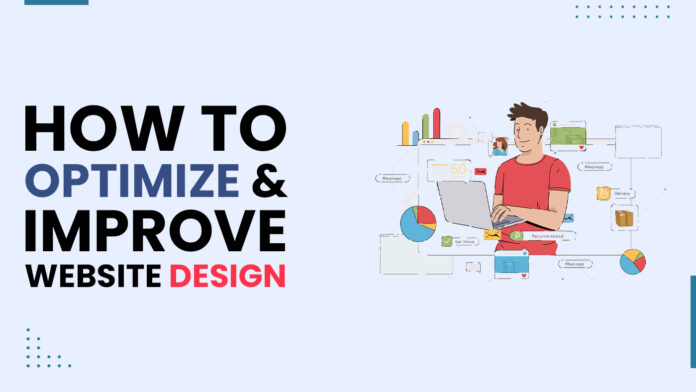Your website serves as a virtual storefront. You want it to be attractive, neat, inviting, clean, and professional looking, just like your regular place of business.
Can your website visitors tell what your company does within five seconds of landing? Could users easily access the blog if necessary? Is your pricing layout simple to understand? Is your website’s bounce rate low?
Website optimization techniques aid in increasing site traffic and conversions. In contrast to search engine optimization (SEO), optimizing your website prioritizes the user experience.
This article will look at How to Optimize and Improve Website Design. Even implementing a few of these strategies should help your site load faster, so let’s get started!
Here are the following ways how To Optimize And Improve Website Design:
1. Improve Page Speed
The page speed of your website is critical for keeping users on the site interesting. Remember that more than 53% of people will abandon a mobile site if it takes more than three seconds to load.
In addition to making your site mobile-friendly and responsive, you should improve your website design by ensuring adequate page speed.
This applies to any website. Blog, business, shopping cart, and so on. Even a 2-second delay in your load time during a transaction increases the likelihood that potential customers will abandon carts, and you will end up with one less customer than you started with.
You can do several things:
- Image Enhancement
- Plugins are being reduced
- Framework and theme cleanup
- Use a CDN (Content Delivery Network) to optimize your homepage
- Think about the Best Hosting Platform
- Use as few redirects as possible
Page speed is linked to other ways to improve website design. Therefore, consider this a top priority when considering website design tips to improve your website’s functionality.
2. Check for a call to action
Consider this: what is the most important action you want visitors to your website to take? Here are three common ones of calls to action:
- Sign up for your email list – When people sign up for your email list, you establish an ongoing connection with them that allows you to market to them. Most email marketing software (Constant Contact, MailChimp, or free for small lists ) allows you to insert a signup box easily.
- Buy online in your e-Commerce store – If you sell the product online, include pictures of a few brands on your webpage to entice purchasers to click thru them, or include an influential “Shop Now” icon.
- Fill out a lead form if you sell services rather than products. It collects contact information so you can follow up.
3. Improve on-page SEO
Optimizing web page content for search engines is known as on-page SEO. Improving it will inform search engines that your website responds to visitors’ queries. On-page SEO is a component of search engine optimization that helps your website rank higher in search engine results pages.
To illustrate, consider the following query on how to build a house and the Google SERPs listing links to improve website design. Google searches for websites that provide the best answers to this search term.
A higher ranking on Google SERPs will result in more organic traffic.
Here are some on-page SEO suggestions:
- Create blog posts – regularly offer additional up-to-date information to boost your ranking in search engines. Follow blog SEO best practices to increase the number of conversions from your posts.
- Conduct keyword research and incorporate keywords into titles, headings, alternative text (alt-text), and content. To increase the reach of some content, consider using a broad keyword. For example, all product pages in an online store should include relevant keywords.
- Include meta titles and descriptions: Write your meta titles and descriptions for all pages and posts.
4. Use hyperlink differentiation:
When you add a link to a page, you’re telling the user that you want them to click there. Make sure that visual cues help you identify links. For example, underlined and differently colored text draws the reader’s attention and informs him or her that this is a link to be clicked on.
According to Karyn Graves’ research, the average web user recognizes blue and underlined text as links and knows to click on them. Success is achieved by capitalizing on user expectations and what they already know about using the web.
There is no need to reinvent the wheel regarding hyperlink differentiation. Instead, blend and remove the color from the design to see what stands out and how effective your links are.
5. Remove Unnecessary Content:
Unbelievably, having a lot of content is not always good. Less is often more in many cases. This is especially true when discussing how to improve website design.
Your website should be simple, easy to navigate, highly qualified, and to the point. It’s about walking the line between saying what you need and being visually intrusive.
You may need to remove certain items from the website. This is referred to as unnecessary content. Getting rid of it will vastly improve website design because they do not adhere to website design best practices. If you have any of the following items on your site, consider removing them:
- Complex Animations
- Long, messy content
- Stocky web images
- Excessive color use
Furthermore, it would help if you exercise extreme caution when selecting words. If possible, go through your current content and look for the following words:
- Next-Generation
- Versatile
- Robust
- Scalable
- Simple to Use
- Innovative
- Groundbreaking
- Cutting-Edge
While these are not necessarily bad words, hundreds, if not thousands, of businesses use them excessively. They add nothing to the appeal or originality of your content.
6. Fix Technical SEO Issues:
Technical SEO is another factor of optimization for search engines. By enhancing the layout of your website, technical SEO makes it simpler for search engines to find your text.
When you create a website, search engines send bots to crawl it and rank each web page. Here are some methods for resolving common technical SEO issues to improve website design:
Improve site structure – your Link building should be constant with better modeling of your web pages. Furthermore, consistent URLs assist website visitors in determining where they are on the site.
Optimize crawling and indexing by submitting your website to search engines so that bots can crawl it more quickly and accurately.
Find broken links and duplicate content – stop search engines from indexing pages with broken links and duplicate content.
Conclusion:
Accessibility, conversion, User experience, ranking, traffic, and rates benefit from website optimization. We’ve compiled a list of strategies for optimizing and improving Denver Web Design Company, including customer feedback, content marketing, and SEO.
After implementing these strategies, make sure to track and measure the performance of your website. Data to consider include your SERP ranking, website traffic, customer retention, and conversion rates.







